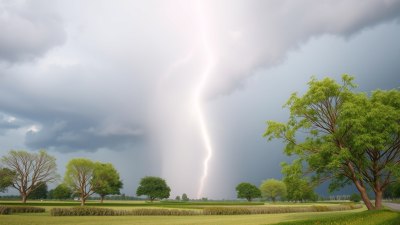Why You’re Drawn to Certain Colors in Your Wardrobe as Seasons Shift
Explore the psychology behind color preferences in your wardrobe as seasons change.

This image was created with the assistance of Freepik
As the seasons transition from one to another, our wardrobes often reflect these changes through the colors we choose to wear. Have you noticed that as the vibrant greens of spring give way to the warm hues of summer, your wardrobe starts to shift accordingly? This phenomenon is not just coincidental; it is deeply rooted in psychology, culture, and even biology. Understanding why you’re drawn to certain colors as seasons shift can help you gain insight into your personal style and how to express yourself throughout the year.
The Psychology of Color
Color is more than just a visual element; it carries a myriad of meanings and emotional responses. Psychologists have long studied the effects that colors can have on moods and behaviors. For instance, warm colors like red, orange, and yellow often evoke feelings of warmth and excitement, while cooler shades like blue and green promote calmness and relaxation. As seasons change, these emotional responses can influence our color choices significantly. In the winter, when days are shorter and the environment is often grey and dull, many find themselves gravitating towards rich, warm colors that provide a sense of comfort and security. During spring and summer, the bright and vibrant colors of nature inspire people to wear lighter, fresher palettes that reflect the energy and renewal of the warmer months.
Cultural Influences on Seasonal Color Choices
Our cultural backgrounds also play a vital role in shaping our preferences for colors throughout the seasons. Different cultures have varying associations with color; for example, white is often associated with purity in Western cultures while it symbolizes mourning in some Eastern cultures. Seasonal celebrations also influence color preferences, such as the vibrant reds and greens during the Christmas season or the pastel colors that dominate Easter festivities. Seasonal fashion trends put forth by designers often respond to these cultural influences; they cycle through different palettes that consumers eagerly adopt. An individual’s cultural heritage can deeply infuse their taste, driving them to favor specific colors as they navigate through the seasons.
Biological Factors and Seasonal Changes
Even biology has a stake in our color choices. Seasonal Affective Disorder (SAD), a type of depression related to changes in season, can alter one’s mood and the colors they find appealing. The body’s natural rhythms react to changes in daylight, which can lead to an increased interest in certain colors. For instance, as serotonin levels fluctuate with the seasons, people may unconsciously choose bright, cheerful colors that counterbalance the darker tones of winter. Similarly, as summer approaches and sunlight increases, people tend to wear lighter, more energetic colors, subconsciously connecting these hues with feelings of happiness and vitality.
The Influence of Fashion Trends
Seasonal fashion trends heavily influence our color choices. Each year, fashion houses and companies typically announce 'color of the season' schemes during fashion weeks, many of which find their way into mainstream wardrobe choices. Notably, Pantone, a leading authority on color in fashion, releases a Fashion Color Trend Report that details the colors predicted to dominate each season. This trend-setting often guides consumers to adopt specific hues that may seem timely and appropriate for the given season. Following these trends can be a unique way to engage with the ever-changing world of fashion while also infusing personal style into seasonal wardrobes.
Emotional Connections to Colors
Colors can evoke strong emotional connections, and as seasons shift, these emotional ties can guide our clothing choices. Think about a closet filled with clothes from various seasons, each piece with memories attached. A certain shade of blue may remind you of a tranquil summer vacation, while earthy tones might bring back memories of autumn trips to the countryside. These emotional anchors can lead to preferences for specific colors during certain seasons as we unconsciously seek to reconnect with those cherished experiences.
Personal Style Evolution
As individuals evolve, so does their sense of style, which can include color preferences. Our experiences, changes in lifestyle, or even changes in mood can directly influence our choices. Someone may find that as they age, their tastes become more aligned with calmer or more muted tones, reflecting a maturing process. Alternatively, others may become bolder in their color choices with personal growth or newfound confidence, especially as seasons dictate a more relaxed or vibrant way to express oneself.
Color, Climate, and Context
The climate itself plays an essential role in the colors we are drawn to. Warmer weather often inspires lighter fabrics in lighter, brighter hues, incorporating colors from the natural environment—think floral patterns and sunny yellows. Conversely, colder months frequently showcase heavier textures in darker, richer colors to counterbalance the chilly atmosphere outside. Context also plays a part; professional settings may lead individuals to opt for muted tones while casual activities might encourage the embrace of more playful, vivid colors.
Fashion and Individual Expression
Ultimately, our clothing choices and preferences for specific colors can be seen as a reflection of our individual expression. Each season offers a new canvas for self-expression, allowing us to play with colors that resonate with our mood and style. Tailoring your wardrobe to the seasons not only keeps your look fresh, but it also opens doors for creativity. The playful experimentation between colors, textures, and styles can foster a deeper connection between self-identity and the world around you.
How to Incorporate Seasonal Colors into Your Wardrobe
- Observe: Pay attention to the colors you naturally gravitate towards each season, and take note of how they make you feel.
- Experiment: Don’t be afraid to step outside your comfort zone. Try mixing colors you normally wouldn’t wear together.
- Shop Mindfully: When adding pieces to your wardrobe, consider opting for transitional colors that can blend through multiple seasons.
- Accessorize: Incorporate seasonal colors through accessories like scarves, bags, or shoes. Accessories are a simple way to express seasonal changes without overhauling your wardrobe.
- Layering: Understand the beauty of layering. During transitional seasons, you can mix and match deep winter hues with lighter spring tones, creating a harmonious blend that reflects the changing environment.
As the seasons change, the colors we choose to wear reflect a complex interplay of psychological, cultural, and biological factors. By understanding these influences, you can make more informed choices about your wardrobe that express your evolving identity and respond to the rhythmic patterns of the seasons. Embrace this seasonal palette, lean into the emotions associated with color, and let your wardrobe tell the story of who you are as you navigate the vibrant tapestry of life.











